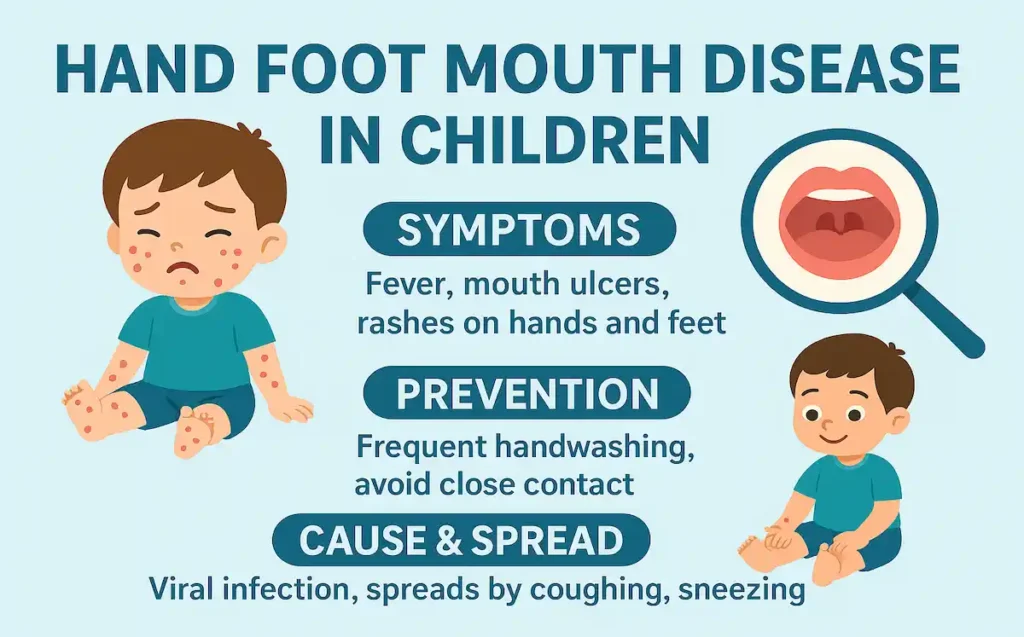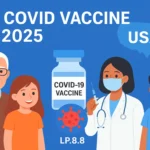1. Introduction: What is Hand Foot Mouth Disease in Children?
Hand Foot Mouth Disease in children (HFMD) is a highly contagious viral disease that mostly affects babies and children below the age of 5 years. It is caused by the coxsackievirus, and is spread through saliva, nasal secretions, feces, and fluid from blisters. Children who attend daycare, playschool, or live in close groups are more likely to get it. The disease causes painful blisters in the mouth, fever, and rashes on the hands and feet. It is one of the most contagious diseases in children, and while it usually clears up in a week, it can cause serious complications if not treated in time. Let us explain in detail its symptoms, causes, and prevention tips for parents.
2. Symptoms of HFMD in Children

2.1 HFMD Symptoms in Children
The early HFMD symptoms in children include sudden fever, sore throat, and loss of appetite. Within 1-2 days, children develop painful mouth ulcers, especially on the tongue, inner cheeks and gums. Soon after, a red rash appears on the hands and feet, sometimes with fluid-filled blisters. Children may be irritable, tired and refuse to eat food due to mouth pain. Since this viral infection spreads rapidly in young children, early recognition of these symptoms helps in rapid care and isolation. Most kids with fever and mouth sores recover in 7–10 days without complications.
2.2 Mouth Ulcers in Children Due to HFMD
One of the painful symptoms of hand foot mouth disease in children is the formation of mouth ulcers in children. These ulcers are red, shallow and very painful. They appear on the tongue, gums and inside of the cheeks. Children may refuse to eat or drink, increasing the risk of dehydration. Drinking cool liquids, soft foods and avoiding spicy or acidic foods may help. Mouth ulcers in children usually last for 5-7 days. Parents should closely monitor fluid intake and ensure that the child is resting and hydrated until he recovers completely from HFMD symptoms.
2.3 Rashes on Hands and Feet: HFMD Sign
A common symptom of hand foot and mouth disease in children is the appearance of rashes on hands and feet. These rashes may look like small red dots or blisters. They usually appear a day or two after the fever starts. These rashes on hands and feet are usually not itchy, but may be painful or sensitive to touch. In some cases, the rash may also spread to the legs, buttocks, or around the mouth. It is important to keep the child’s skin clean and avoid scratching during the HFMD symptoms phase.
2.4 Kids with Fever and Mouth Sores: When to See a Doctor
If yourkids have fever and mouth sores, especially with a rash on the body, it could be a sign of hand foot mouth disease in children. While most cases are mild and can be treated at home, you should call a doctor if your child stops drinking fluids, has a fever higher than 102°F (39°C) or seems very lethargic. Painful mouth ulcers in children can quickly lead to dehydration. Timely treatment ensures that the illness does not become severe. Don’t ignore these signs – Children with fever and mouth ulcers (kids with fever and mouth sores) need care and attention.
According to the Centers for Disease Control and Prevention (CDC), HFMD is a common contagious viral illness that primarily affects young children. The World Health Organization (WHO) also highlights the importance of hygiene to prevent its spread.3. Causes and Transmission
3.1 Viral Infection in Toddlers: How HFMD Spreads
HFMD is a viral infection in toddlers that spreads through bodily fluids — saliva, mucus, or stool. By putting infected toys or fingers in their mouths, toddlers frequently contract it. It can also spread through coughing, sneezing, or touching surfaces touched by an infected person. This makes daycare centers a hotspot. Symptoms start within 3–5 days after exposure. It’s important to keep your child home during the infection period. Recognizing the viral infection in toddlers early and limiting contact helps prevent the spread of hand foot mouth disease in children.
3.2 Communicable Diseases in Children: Why HFMD is a Concern
Among all communicable diseases in children, HFMD is one of the most common during summer and fall seasons.It spreads rapidly in congregate settings such as schools and playgrounds. Children can easily contract the virus through direct contact or shared objects. What is worrying is how quickly it can affect many children in one place.. Although usually mild, it can cause severe dehydration or discomfort. Parents and teachers should be aware of symptoms and prevention to reduce the rise of communicable diseases in children, especially viral ones like HFMD.
4. Diagnosis and Treatment
4.1 How to Diagnose HFMD in Children?
Hand foot mouth disease in children is often diagnosed clinically — meaning the doctor checks the child’s symptoms and physical signs like mouth ulcers, rashes on hands and feet, and fever. Usually no lab tests are needed unless symptoms get worse. The pediatrician may inspect the mouth for blisters and sores, and ask about recent exposure to other sick children.. Since HFMD symptoms can look like other illnesses (like chickenpox or measles), accurate diagnosis is key. Always consult a doctor if you’re unsure, especially if the viral infection in toddlers seems severe or doesn’t improve within 3–5 days.
4.2 Is HFMD Dangerous? What Are the Complications?
In most cases, hand foot mouth disease in children is mild and self-limiting. However, complications can occur. The most common is dehydration due to painful mouth ulcers in children, leading to reduced fluid intake. In very rare cases, the virus can affect the nervous system, causing meningitis or encephalitis. Children with weakened immune systems or underlying conditions should be monitored closely. If your child is showing signs of confusion, persistent high fever, or breathing difficulty, seek emergency care. Early management reduces the risks from this communicable disease in children.
4.3 Best Foods and Fluids for Kids with HFMD
When a child has mouth ulcers in HFMD, eating becomes painful. Offer soft, cool foods like yogurt, banana, mashed potatoes, or smoothies. Avoid sour or spicy foods such as orange juice or tomato sauce. Hydration is very important – give coconut water, plain water or diluted fruit juice. Ice cubes can help relieve mouth pain.. Kids with fever and mouth sores may refuse
food, so keep feeding them fluids frequently. This not only soothes the throat but also prevents dehydration, which is a serious concern during hand foot mouth disease in children.
5. Prevention and Hygiene Practices
5.1 HFMD Prevention in Kids
Effective HFMD prevention in kids starts with hygiene. Teach children to wash their hands frequently with soap, especially after using the toilet or playing outside. Disinfect toys and surfaces regularly. Avoid close contact with infected children or their belongings. In daycare, isolate the infected child for at least 7 days. Encourage covering the mouth and nose when sneezing. Proper hygiene practices significantly reduce the risk of hand foot mouth disease in children. Parents must stay alert during outbreaks and practice preventive care to avoid the spread of this communicable disease in children.
5.2 Cleaning Tips to Prevent HFMD Spread at Home
HFMD spreads rapidly if hygiene is not maintained at home. Wash your child’s hands frequently with soap, especially after using the bathroom or playing. Disinfect surfaces such as tables, door handles, toys and toilet seats daily using bleach or an alcohol-based cleaner. Wash clothes, towels and bedding separately in hot water. Parents should also wash their hands after changing diapers or wiping off saliva. These practices are crucial to stop this viral infection in toddlers from affecting siblings or others. Early cleaning can stop HFMD from turning into a household-wide communicable disease in children.
6. Recovery and Return to Routine
6.1 When Can Kids Return to School After HFMD?
Most schools recommend keeping children home for at least 7 days after HFMD symptoms appear. Children are most contagious during the first week. Even after symptoms disappear, the virus can remain present in the stool for several weeks. Ensure that rashes on hands and feet are dry and no new ulcers are forming.Before sending your child back, confirm guidelines with your doctor or school. Returning too early can cause outbreaks, especially in preschools. Letting the child rest also ensures complete recovery from hand foot mouth disease in children.
6.2 Do Adults Get HFMD? Can Parents Catch It?
Yes, although HFMD is most common in toddlers, adults — especially parents and caregivers — can also catch it. In adults, symptoms are usually milder but may still include fever, sore throat, mouth ulcers, or skin rashes. It is important to maintain hygiene when caring for infected children. Wash hands thoroughly after contact and avoid sharing food or utensils. Pregnant women should also be careful as HFMD can rarely cause complications. Parents must protect themselves to prevent further spread of this communicable disease in children and families.
6.3 Is There a Vaccine for Hand Foot Mouth Disease?
Currently, there is no vaccine available for the Coxsackievirus strain that causes most cases of hand foot mouth disease in children, especially in the U.S. and Europe. However, China has approved a vaccine for EV71 strain (a more severe variant). Research is ongoing globally. Until then, the best protection remains HFMD prevention in kids through hygiene, awareness, and quick isolation. Parents should stay updated with pediatric guidelines and news about possible future vaccines that could prevent this viral infection in toddlers.
Frequently Asked Questions (FAQs)
Q1: Is hand foot mouth disease serious in children?
Usually not, but if untreated, dehydration or secondary infections can occur.
Q2: Can my child get HFMD again?
Yes, multiple strains exist. One infection doesn’t provide lifelong immunity.
Q3: Can siblings get infected from one another?
Yes, it’s a highly communicable disease in children, especially with shared items and close contact.
Q4: Are rashes on hands and feet itchy?
Not always. They can be painful or blister-like.
Conclusion
Hand Foot Mouth Disease in children is a common but uncomfortable illness that can spread rapidly if not managed early. By understanding the symptoms, especially mouth ulcers, fever, and rashes on hands and feet, and following hygiene-based HFMD prevention in kids, parents can protect their child and others. Always be cautious of any viral infection in toddlers, and remember that communicable diseases in children like HFMD are best controlled with early detection, proper care, and good hygiene practices.
Urgent 2025 Measles Warning: Signs & Protection, Also Read.






